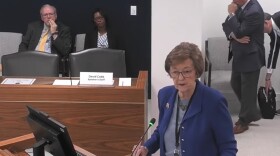This article first appeared in the WFAE Climate News newsletter. You can sign up here to get the latest environmental news to your inbox first.
The Catawba Riverkeeper Foundation last month released its third plan to restore and protect the Catawba River Basin: the South Fork Catawba Sub-Basin Restoration and Protection Plan. The Catawba River Basin covers 5,000 square miles and 26 counties across two states. The area includes familiar water bodies like Lake Norman and Mountain Island Lake.
This is a massive area to cover. So, to better plan, the Catawba Riverkeeper Foundation broke the basin down into sub-basins — smaller water systems that feed this one big one. The largest of these tributaries is the South Fork Catawba River, which starts in South Mountains State Park in Burke County, spans four counties, and ends in Lake Wylie.
The South Fork Plan is a wish list of 22 projects that would improve water quality along the South Fork Catawba River and its adjoining streams and waterways, or tributaries. The Catawba Riverkeeper’s projects meet three criteria:
- The project improves water quality. That’s priority #1.
- There is funding available for it.
- People want that project completed.

“We’re not going to go into a community and say, ‘Hey! We’re here to fix everything,’” said Catawba Riverkeeper Brandon Jones. “Our best projects are projects that have been identified by other groups that we can collaborate on.”
The South Fork Catawba Basin includes some of the most rural areas in the Catawba River Basin — and some of the most quickly changing areas. Towns west of Charlotte, such as Gastonia, Belmont, and McAdenville, are all growing rapidly. At the same time, the headwaters of the South Fork remain protected by South Mountains State Park.
The way people use the land surrounding the South Fork varies greatly, and it’s changing rapidly, which means the South Fork is experiencing a wide array of impacts. Fast-moving stormwater accelerates shoreline erosion near urban areas. When the water becomes increasingly murky, it reduces habitat for the critters fish eat.
“It's also very difficult for some of the fish, especially our fancier fish, like trout,” Jones said. “They can't survive if the water is too turbid.”
Livestock grazing and agricultural runoff impact water quality in more rural areas. The Catawba Riverkeeper Foundation has found high levels of E. coli bacteria in the water after heavy rainfall near poultry concentrated feeding operations, or CAFOs.
Protecting the waters from future harm is one thing, but of the 748 miles of streams and rivers that make up the South Fork Sub-Basin, over 15% of those waters are no longer fishable, drinkable, or swimmable, landing them on the state’s 303(d) impaired waters list.
“You should be able to hop in the water and not get sick,” Jones said. “Over a hundred miles [in the South Fork Basin] have failed to meet that criteria.”
What separates the South Fork from other sub-basins in the Catawba River Basin is that it is free-flowing. There aren’t any major lakes or reservoirs until you reach the South Fork’s terminus at Lake Wylie. However, many abandoned or derelict dams prevent water from flowing naturally. In some cases, old mills constructed dams to convert water into electricity and pool drinking water for the community.
But water isn’t the only thing that collects behind the dam — sediment accumulates at the dam instead of replenishing eroded shorelines downstream. Dams can also block fish and impact biodiversity.

The Catawba Riverkeeper Foundation has already received some funding to begin projects along the South Fork, including planting trees and creating a better public access point at South Mountains State Park. Removing the Old Fort Finishing Dam is on the Northern Catawba Basin Plan, which has received funding to determine the cost and logistics of removing the dam. The South Fork Plan also includes three dam removal projects.
“We just want to get projects off the ground, going now,” Jones said. “The point is to start as soon as possible on as many things as possible. We want to have irons in the fire.”







